
Nadir Shah (1688-1747) was a great warrior and ruler of Persia ( modern Iran ) . His real name was Nadir Quli. He was the founder of the Afshar dynasty and is called the ” Napoleon of Iran ” . His military prowess and conquests made him immortal in history.
Characteristics and major events of Nadir Shah :
Political rise :
Nadir Shah was born into a modest family and rose to power through his military brilliance. He unified Iran after the fall of the Safavid Empire and founded the Afshar dynasty.
Invasion of India (1739):
Nadir Shah’s invasion of India is one of the most talked about events in history. He defeated the Mughal emperor Mohammed Shah Rangeela and captured Delhi. He then took immense wealth from India , such as the famous Kohinoor diamond. And took the Takht – e – Taous ( Peacock Throne ) to Persia .
Military Strategies :
His warfare combined swiftness , cleverness , and ferocity. His army was known for its discipline and strategy.
Conquests : He
conquered many parts of Central Asia , India , and the Ottoman Empire. His conquests made him one of the most powerful rulers of Persia.
Death :
Due to Nadir Shah’s extreme cruelty and suspicion, his own generals murdered him in 1747 .
Nadir Shah is known in history as a skilled commander and strategist , but his cruelty and extreme greed made his rule controversial.
Nadir Shah (1688-1747) was a great warrior , general and ruler of Persia ( present-day Iran ) . He was the founder of the Afshar dynasty and is considered an important personality in the history of Iran. His military prowess , conquests and administrative ability brought him fame , but he also became controversial due to his cruelty and excessive ambition.
Early Life :
Nadir Shah was born on 22 October 1688 in Khorasan ( north – eastern region of present-day Iran ) . His real name was Nadir Quli Beg His family was a simple shepherd family and his father died in his childhood. He had to struggle hard due to poverty. He established himself as a skilled warrior in his youth.
Rise to power :
Nadir brought unity to Persia after the fall of the Safavid Empire. He defeated slaves , rebels and external invaders with his military prowess. With the help of the Safavid king Tahmasp II, he liberated Persia from enemies and declared himself the ruler of the country. In 1736 he formally assumed the title of king and founded the Afshar dynasty.
Descriptions of military campaigns and victory tours :
Conquest of Central Asia and the Ottoman Empire :
- Nadir Shah conducted successful military campaigns against the Ottoman Empire and Russia. He strengthened Persia’s western borders and recaptured the former territories of the Safavid Empire.
Invasion of India (1739):
- Nadir Shah’s invasion of India was his most famous and important victory. He took advantage of the weak military position of the Mughal emperor Muhammad Shah Rangeela.
- He defeated the Mughal forces badly in the Battle of Karnal near Panipat and captured Delhi in March 1739 .
- In Delhi, he carried out a massive massacre and looted the city. He also took away the Kohinoor diamond , the Darya – i – Noor diamond , and the famous Takht – i – Taus ( Peacock Throne ). He took immense wealth including this to Persia.
Other Victories :
- Nadir Shah also expanded his campaigns into Afghanistan , Central Asia, and other parts of the Indian subcontinent.
Rule and brutality :
Nadir Shah’s rule is known for his military and administrative skills on the one hand , and for his cruelty and extreme greed on the other. He maintained discipline in his army , but his attitude towards the public and opponents was extremely harsh.
- He tried to reform the tax system and modernize the army.
- Due to his suspicious nature, he used to punish his colleagues and officers , which increased dissatisfaction against him.
Death :
Nadir Shah’s extreme cruelty and greed turned his own generals and courtiers against him. In 1747 , he was assassinated by his own soldiers. After his death the Afshar dynasty weakened and their empire began to decline.
Legacy of Nadir Shah :
Nadir Shah was considered a great warrior in the history and strategists Known as the Pharaoh, his conquests and military campaigns made Persia an important power , but his cruelty and internal strife did not allow his empire to last long.
His reign may be briefly recalled as follows :
- Military conquest and imperial expansion.
- Loot of immense wealth and famous items ( like Kohinoor ) .
- Brutal rule and political instability.
Nadir Shah is still recorded in the pages of history as a ruler who had both immense achievements and controversies .
Early Life of Nadir Shah’s
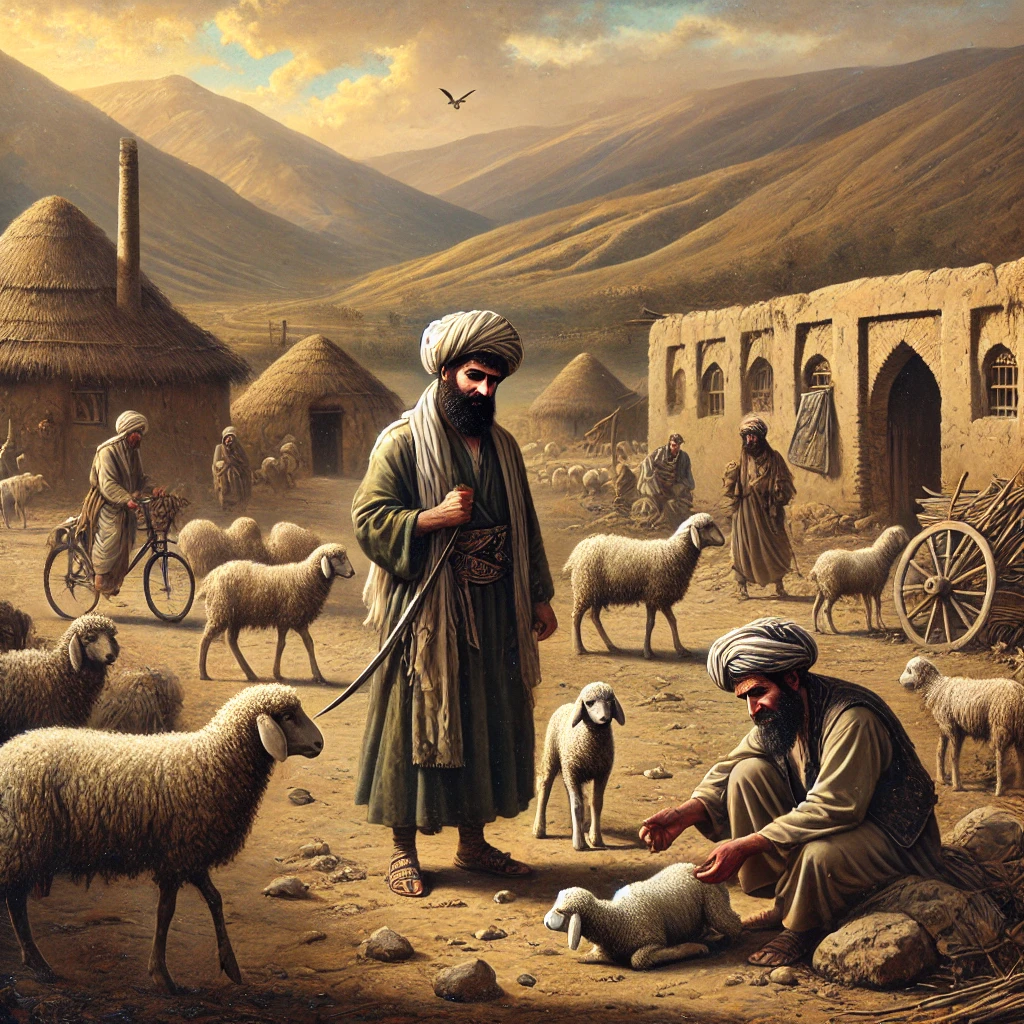
Nadir Shah’s early life was full of struggle , poverty , and adversity. He was born on 22 October 1688 in Khorasan He was born in a small village of Qajar , which is located in the north – eastern region of present-day Iran . He was born in a simple and poor Turkmen family. His father’s name was Imam Quli Beg Nadir Shah was a simple shepherd. Nadir Shah’s real name was Nadir Quli Was.
Family and childhood
- Nadir Shah’s family was very poor and he faced many difficulties in his childhood. His father had limited resources , which made it difficult to support the family .
- When Nadir was only 13 years old , his father died. This put the family in further difficulties.
- After the death of his father, Nadir and his mother had to face difficult circumstances. Due to poverty and lack of resources, Nadir did not get the opportunity to study .
slavery and difficult conditions
- After his father’s death , Nadir had to work hard to support his family .
- He was also once sold as a slave , but his sharp intelligence and courage helped him find a way out of these circumstances.
- Nadir acquired proficiency in the arts of war, such as handling weapons and horse riding , which became his greatest strength in the future.
Entry into the Army and early experiences
- Nadir began his military journey as a teenager by joining the armies of local chieftains. He participated in small conflicts and demonstrated his bravery and leadership abilities.
- The struggle in Nadir Shah’s early life developed a combative and determined personality in him. He was always ready to prove himself in every situation.
Learning from struggles and ambition
- Nadir’s struggles in his early life aroused within him a strong ambition to gain power and authority.
- He soon realised that an organised army and efficient leadership were the keys to success.
Early life legacy
Nadir Shah’s early life shows that even adverse circumstances can make a person great , provided he puts his skills and courage in the right direction.
His childhood poverty , slavery and struggles made him a man who never gives up . This determination and confidence is clearly reflected in his future military campaigns and rule.
The Napoleon of Iran
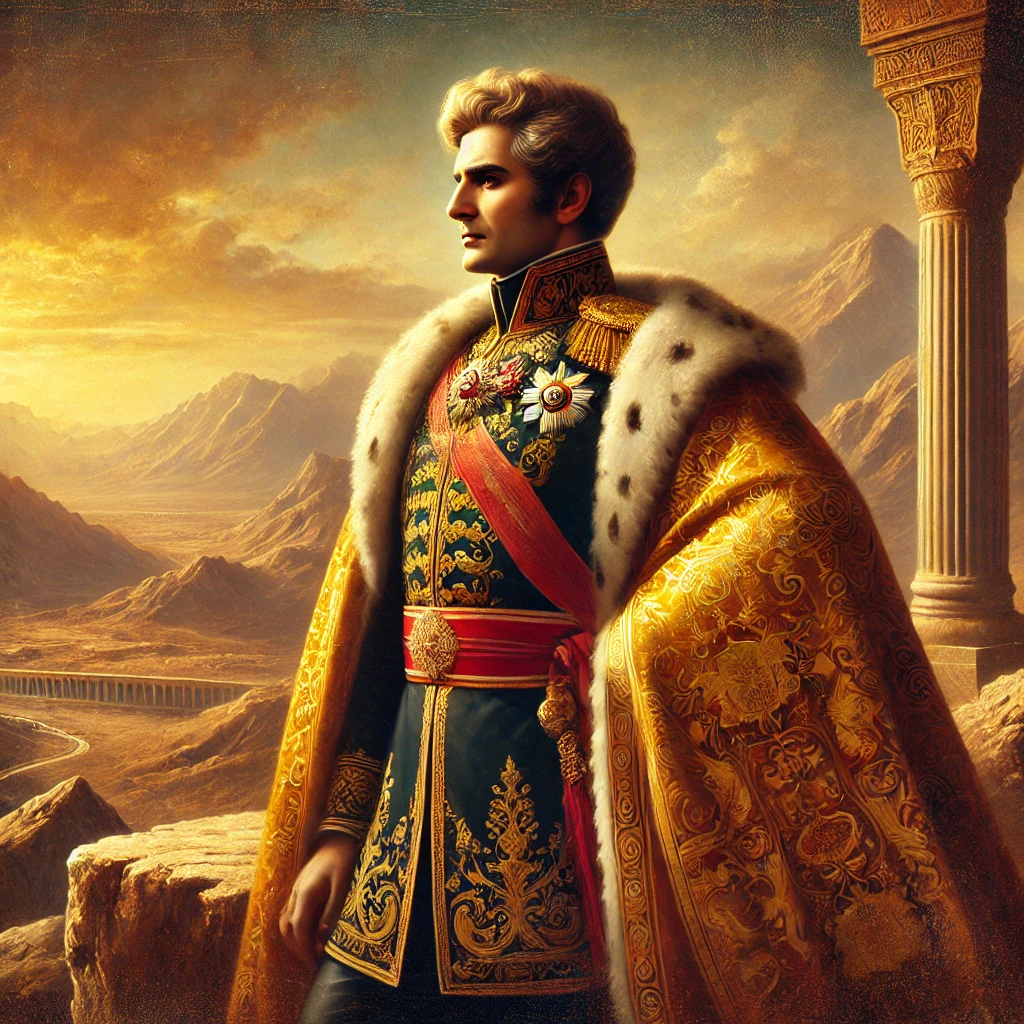
Nadir Shah, known as ” Napoleon of Iran ” He was given this title because of his military prowess , strategic victories , and his leadership skills. This epithet is mainly used to compare him with the French emperor and great commander Napoleon Bonaparte. Both the rulers were famous for their unique military strategies and conquests. The life and achievements of Nadir Shah are a golden chapter in the history of Iran. Let us understand it in detail.
Nadir Shah called ” Napoleon of Iran ” ?
Military skills and strategist :
- Nadir Shah made Persia a very powerful military nation during his time. He adopted military strategies that are still considered inspirational today.
- He organised the weak and scattered Persian army and made it into a powerful force that could challenge neighbouring states.
- Like Napoleon , Nadir Shah was always present on the battlefield with his army and his leadership was his greatest strength.
Reviving the political situation :
- Just as Napoleon provided stability and leadership to the country at a time of political and social instability in France , Nader Shah united Iran after the collapse of the Safavid Empire and protected it from internal and external threats.
- He united the various regions and ethnicities , bringing stability to Persia.
Similarities in Vijay Abhiyan :
- Nadir Shah, with his military prowess, conquered large parts of Central Asia , India , and the Ottoman Empire.
- 1739. He defeated the Mughal army in the Battle of Karnal and captured Delhi.
- Like Napoleon , Nadir Shah also challenged many powerful empires of his time and conquered many territories.
Economic gain and plunder :
- Nadir Shah took immense wealth and precious items to his country during the looting of Delhi. This included the famous Kohinoor diamond and Takht – e – Taus ( Peacock Throne ) Are included.
- These achievements strengthened Persia’s economic position , just as Napoleon gave economic and political power to France through his conquests.
Military and Administrative Reforms :
- Nadir Shah modernized and disciplined the Persian army. He gave the soldiers better weapons and adopted new strategies.
- Like Napoleon , he also reformed his administrative structure and strengthened the tax system.
Similarities between Nadir Shah and Napoleon :
| Speciality | nadir shah | Napoleon Bonaparte |
| Military leadership | Made the Persian army organized and powerful. | Made the French army the most powerful army in Europe. |
| Vijay Abhiyan | India , Afghanistan , the Ottoman Empire, and Central Asia. | Conquered most of Europe. |
| Administrative reforms | Tax reform and modernization of the army. | Administrative , legal and social reforms. |
| Controversy and brutality | Famous for cruel rule and plunder of Delhi. | Criticism due to lust for power and wars. |
| Downfall | Murdered because of his cruelty and suspicious nature. | Defeat at the Battle of Waterloo and exile. |
Weaknesses of Nadir Shah :
- Extreme Cruelty : Nadir Shah’s reign is also known for his cruelty and extreme harshness. He imposed harsh punishments on opponents and subjects , which increased discontent.
- Tendency to doubt : Being too suspicious of his colleagues and officers proved to be his weakness. Due to this, he was ultimately killed by his own soldiers.
- Lack of political stability : Persia once again became unstable after his reign , as he did not create a permanent administrative system.
Heritage :
Nadir Shah being called the ” Napoleon of Iran ” is a tribute to his accomplishments and unparalleled military skill. His conquests and reforms kept Persia a strong power until his death. However , his brutality and hunger for power made his legacy controversial.
His story teaches us that to become a great warrior and ruler, not only victory but also the trust of the people and a stable administrative system is required.
Nadir Shah’s Political Rise
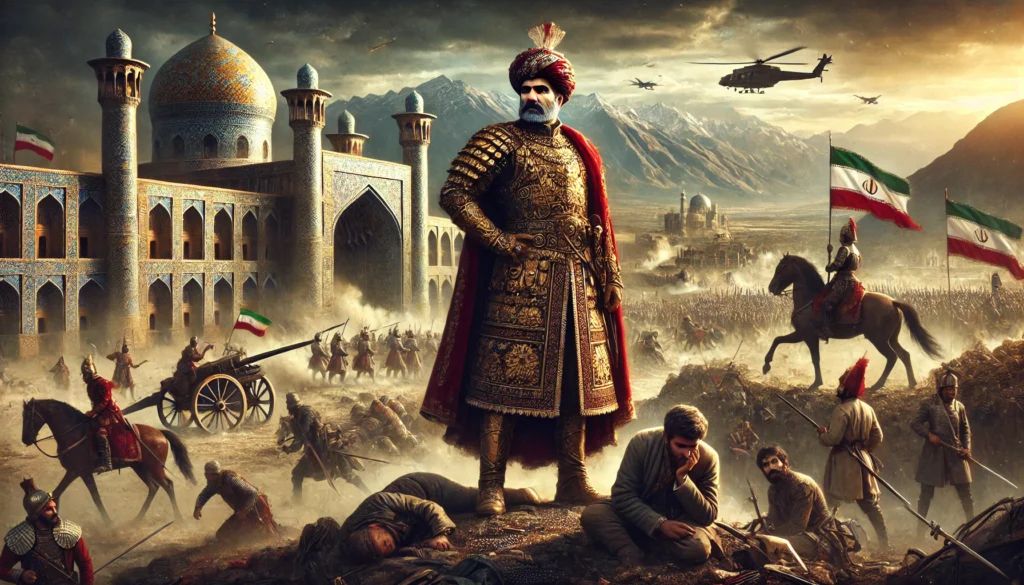
Nadir Shah’s political rise was the result of his extraordinary military skill , strategic vision , and leadership ability. His journey began in 18th century Persia ( present-day Iran ) , when the Safavid Empire was heading towards decline. During this time Persia was surrounded by political instability , external invasions, and internal rebellions. Nadir Shah took advantage of this chaos and paved his way to power.
Condition of the Safavid Empire :
- the 18th century the Safavid Empire had weakened. Due to its weak military position and administrative inefficiency, Persia began to be invaded from outside.
- The Ottoman Empire and Afghan invaders occupied large parts of Persia.
- 1722, the Afghan Ghilzai tribe captured Isfahan, the capital of Iran, and dethroned Shah Sultan Hussein, emperor of the Safavid dynasty.
Rise of Nadir Shah :
Initial military service :
- Nadir Shah began his military journey serving under a local chieftain. His war skills and leadership abilities soon brought him to prominence.
- He took part in small battles and gradually prepared his army.
Alliance with Tahmasp II :
- Tahmasp II, son of Shah Sultan Husayn, former emperor of the Safavid dynasty Tried to regain his rights to the throne.
- Tahmasp II recognised Nadir Shah’s military talent and appointed him as his chief commander.
- Nadir launched a campaign against the Afghan Ghilzai tribe in eastern parts of Persia and defeated them, restoring Isfahan under the control of the Safavid Empire.
Victory over Afghans :
- Nadir Shah fought a decisive battle against the Afghans and defeated them in 1729. This was his first major victory , which made him an influential commander of Persia.
- After this victory he restored Tahmasp II to the throne of Isfahan.
Campaign against the Ottoman Empire :
- Nader Shah launched a military campaign against the Ottoman Empire , which had occupied the western parts of Persia.
- liberated the regions of Kurdistan , Azerbaijan, and Khorasan from the Ottomans.
- His military success established him as the de facto leader of Persia.
Dethroning of Tahmasp II :
- Due to the incompetence and mistakes of Tahmasp II, Nadir Shah removed him from the throne.
- He succeeded to the throne as Tahmasp’s younger son, Abbas III He made him king and declared himself his guardian.
- This move was a turning point in Nadir Shah’s political rise , as he was now at the centre of real power.
Being declared king :
- In 1736 , Nadir Shah also dethroned Abbas III and declared himself King of Persia.
- He formally established the Afshar dynasty Established the , which succeeded the Safavid dynasty.
Leadership and administrative efficiency of Nadir Shah :
- Nadir Shah unified Persia and made it a strong military power.
- He established peace and stability in various regions of Persia.
- He reformed the tax system and equipped his army with modern weapons.
Importance of political rise :
Nadir Shah’s political rise was not only a symbol of his military brilliance and leadership ability , but it also reflects the chaos and instability of Persian politics of that period.
He not only united the weak and scattered Persia , but also made it one of the most powerful military powers of his time. His rise is placed in the category of those leaders in history , who ended the chaos and gained power with their skill and perseverance.
Rule and Brutality
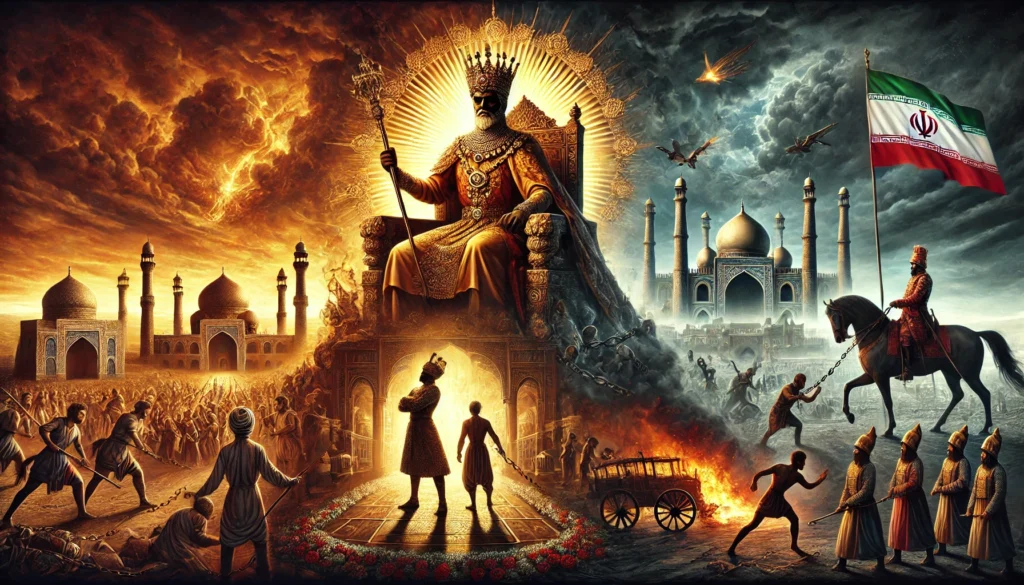
Nadir Shah’s reign (1736–1747) is known for his unparalleled military achievements , administrative reforms, and expansionist policies. However , his rule was also controversial due to his excessive brutality , lust for power , and harshness towards his subjects. Nadir Shah established Persia as a great power once again , but his cruelty and atrocities made his rule infamous.
Features of Governance :
Creation and expansion of military power :
- Nadir Shah made the Persian army extremely powerful and modern.
- They adopted new weapons and warfare techniques.
- His army conquered regions such as the Ottoman Empire , Afghanistan , and India.
economic policies :
- Nadir Shah reformed the tax system and attempted to bring financial stability.
- He strengthened the economy of Persia by plundering Delhi in India.
- However , excessive taxation placed a heavy burden on the subjects and led to discontent.
religious tolerance :
- He attempted to reduce sectarian tensions between Shia and Sunni Muslims.
- Nadir Shah presented himself as a secular ruler and tried to unify Persia on religious grounds.
Administrative Reforms :
- He strengthened the central administration and adopted strict policies to bring stability to the different regions of the empire.
- Nadir Shah controlled the power of the local chieftains and jagirdars.
Cruelty and atrocities :
Burden of excessive taxes on the people :
- Nadir Shah imposed high taxes to continue his military campaigns and enrich the empire.
- This tax policy proved unbearable for the common people and gave rise to many revolts.
Suppression of political opponents :
- Nadir Shah was an extremely suspicious ruler. He ruthlessly suppressed his opponents and potential threats.
- He got many chieftains , courtiers , and even his own relatives killed.
Loot and massacre of Delhi (1739):
- During his conquest of India , Nadir Shah plundered Delhi and took immense wealth to his empire.
- His army carried out widespread massacre in Delhi , killing thousands of innocent people.
- The plunder and cruelty of Delhi is one of his most infamous incidents.
Cruelty against internal rebellions :
- Towards the end of his reign , rebellions broke out in several areas.
- Nadir Shah suppressed these rebellions with extreme brutality.
Cruelty towards family and court :
- Nadir Shah’s suspicious nature led to his downfall.
- He also had his own son , Reza Quli Mirza , blinded, accusing him of usurping power.
Fall of the empire due to cruelty :
- Nadir Shah’s cruel policies and atrocities destroyed his popularity.
- The people and the courtiers became dissatisfied with him.
- His final years saw increased revolts in various parts of the empire.
- In 1747 , he was assassinated by his own soldiers in a conspiracy.
Impact of Cruelty and Rule :
- Nadir Shah transformed Persia into a strong empire , but his brutality negatively affected his legacy.
- After his reign , his attempts to bring stability to Persia failed , and the Afshar dynasty quickly weakened.
- After his death Persia again plunged into political chaos.
conclusion :
Nadir Shah’s rule was a double-edged sword. He strengthened Persia militarily and economically , but his cruelty , tyranny and lust for power made his rule controversial.
He is remembered in history as a great commander and a skilled strategist , but his cruelty and resentful rule became the main cause of his downfall. His story teaches that power and military conquest are sustainable only when combined with justice , tolerance and support of the people.
Legacy of Nadir Shah
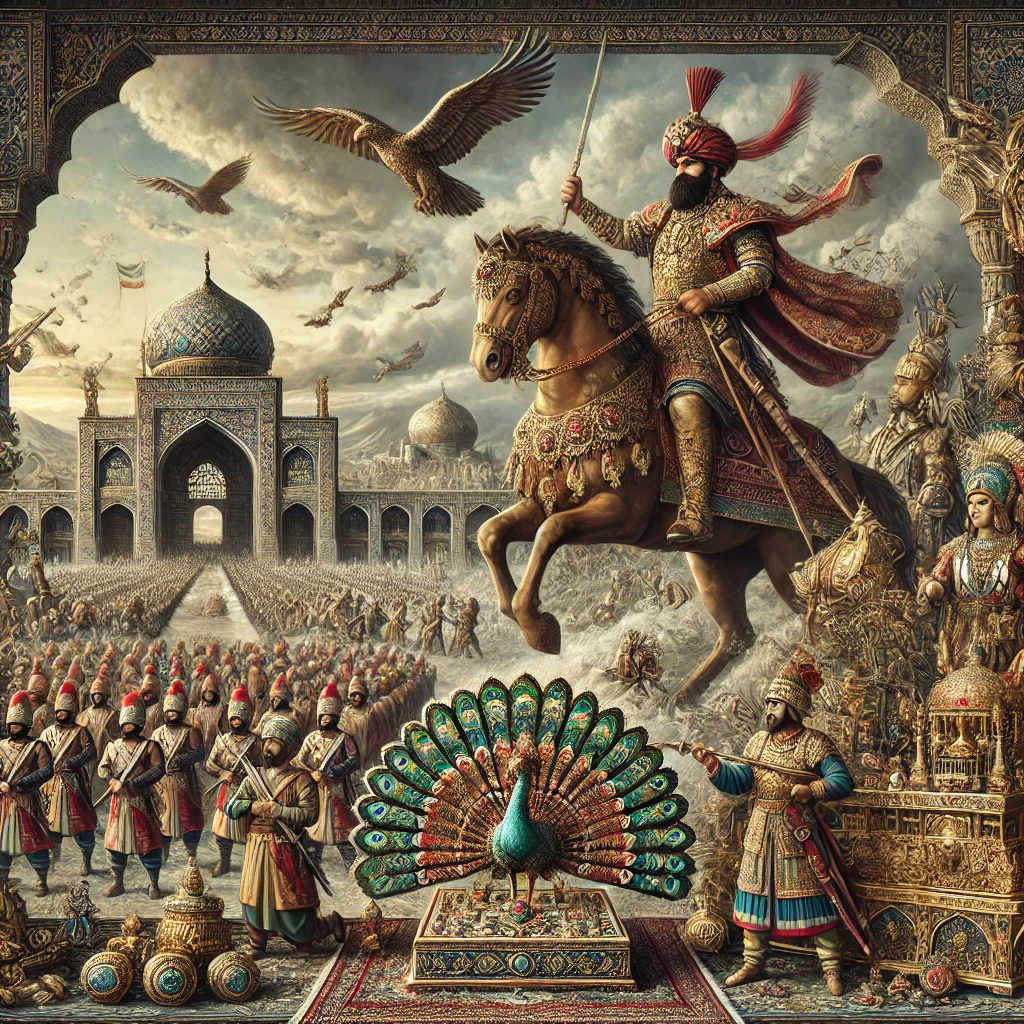
Nadir Shah’s legacy encompasses the dual aspects of his military prowess , empire expansion , economic contributions , and reforms to the political structure as well as his cruelty and atrocities. His reign established Persia as a major power , but the weaknesses of his policies and rule became apparent after his death. His legacy had a wide-reaching impact on the history of Iran , Central Asia, and the Indian subcontinent.
Legacy of Nadir Shah :
1. Military achievements :
- Restoring Persia : Nadir Shah transformed weak and disintegrated Persia into a powerful military nation.
- Military strategy : His military strategies and fighting skills are still a subject of study in military history.
- achieved successes over the Ottoman Empire , the Afghan Ghilzai , and the Mughals.
- In India, the plunder of Delhi and the Battle of Karnal are symbols of his military strength.
2. Expansion of the Empire :
- Nadir Shah greatly expanded the borders of Persia during his reign. His empire included Iran , Afghanistan , large parts of Central Asia and a part of the Indian subcontinent.
- His conquests made Persia one of the greatest powers of the time.
3. Economic impact :
- Loot of Delhi : The plunder of Delhi brought immense wealth to Persia. The Koh-i-Noor diamond and the Peacock Throne ( Takht – i – Taus ) were among their most famous loots.
- His economic policies provided Persia with short-term economic stability.
- However , the excessive tax system discontented the people and led to revolts.
4. Religious and cultural influences :
- religious tolerance : Nadir Shah tried to establish unity between Shia and Sunni Muslims. He tried to bring together the different sects of Islam.
- Art and Architecture : During his reign, Persian architecture and cultural influence got a new dimension.
5. Political Structure :
- Nadir Shah established a centralised administrative system , which persisted for some time after his death.
- He founded the Afshar dynasty , although this dynasty did not last long after his death.
Negative Legacy :
1. Cruelty and atrocities :
- Nadir Shah’s reign was notorious for his cruelty and extremely harsh policies.
- His suspicious nature and hunger for power led him to display brutality against his comrades , soldiers , and family members.
- His popularity declined due to his cruelty , and he became a symbol of fear for his subjects.
2. Decline of the Empire :
- Soon after Nadir Shah’s death, his empire disintegrated.
- The Afshar dynasty founded by him could not last long due to weak leadership and internal conflicts.
- Persia again plunged into political chaos and instability.
3. Revolt and discontent :
- Nadir Shah’s excessive taxation policy and atrocities on his subjects led to an increase in the number of rebellions during his reign.
- His brutal policies undermined his efforts to establish lasting peace and stability in Persia.
Global image of Nadir Shah :
1. ” Napoleon of Iran “:
- Nadir Shah is called the ” Napoleon of Iran ” . This epithet refers to his military success and leadership ability.
- However , like Napoleon , Nadir Shah’s downfall was due to his lust for power and overly harsh policies.
2. Impact in India :
- Nadir Shah’s invasion of India and the plunder of Delhi weakened the power of the Mughals in the Indian subcontinent.
- Their plunder accelerated the decline of the Mughal Empire and allowed the Marathas and other regional powers to rise.
3. Impact on Central Asia and the Ottoman Empire :
- Nadir Shah’s campaigns affected the political balance of Central Asia and the Ottoman Empire.
- His conquests established Persia as a strong military power in these regions.
conclusion :
Nadir Shah’s legacy is divided into two aspects.
- On the one hand , he is remembered as a great general and strategist who made Persia a powerful military and political power.
- On the other hand , his cruelty , tyranny , and lust for power made his rule short-lived and pushed his empire into collapse soon after his death.
Nadir Shah’s story is both a symbol of the potential of a great leader and a warning of his downfalls. His legacy teaches history that power and victory are only lasting when combined with justice , tolerance, and the support of the people.
Invasion of India
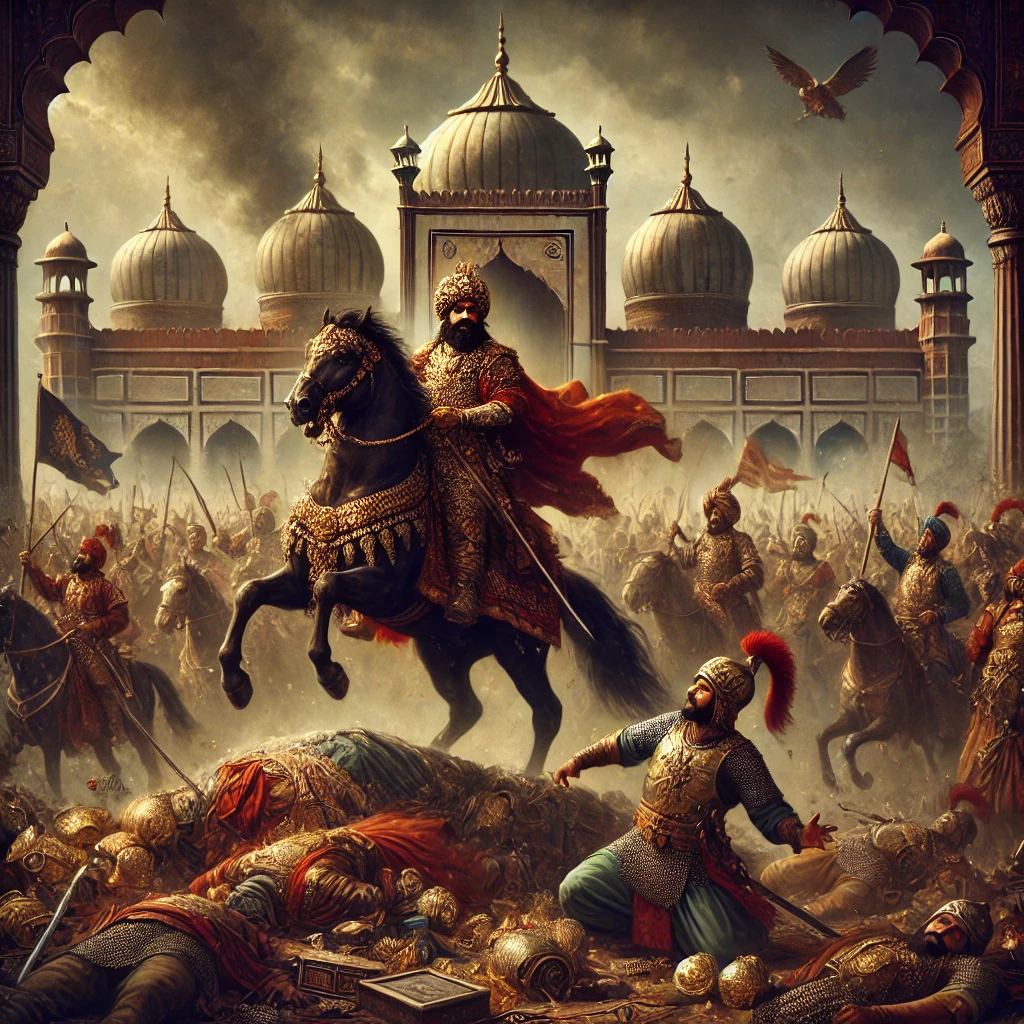
Nadir Shah’s invasion of India (1739) is one of the most devastating and talked about events in history. It was not only a symbol of his military power and expansionist policy , but it also had a profound impact on the political and economic structure of the Indian subcontinent. The main purpose of this invasion was to loot wealth and demonstrate his military strength.
Background of the attack on India :
Weaknesses of the Mughal Empire :
- the 18th century the Mughal Empire had become extremely weak.
- After Aurangzeb’s death (1707) , the empire was in decline due to political instability , succession struggles , and the rise of regional powers.
- The administrative and military structure of the empire had disintegrated.
Weakness in the security of the north – western borders :
- northwestern frontier of the Mughal Empire , which extended to Afghanistan and the Khyber Pass , had weakened.
- The Mughal borders were insecure due to border disputes with Persia and internal rebellions.
Objective of Nadir Shah :
- was to acquire wealth for Persia .
- Having learnt about the weakness of the court of Delhi and its rich wealth he decided to invade India.
Process of attack :
1. Departure from Persia and advance towards India :
- Nadir Shah launched a campaign to invade India in 1738 .
- He entered India through the Khyber Pass, passing through Kandahar and Ghazni.
- The Mughal army posted on the Indian borders was unable to stop them.
2. Battle of Karnal (24 February 1739):
- Mughal emperor Mohammed Shah was buried in Karnal, about 110 km from Delhi. faced Nadir Shah’s army.
- Nader Shah’s army was smaller than the Mughal army , but better organised and strategically capable.
- The Mughal army suffered a terrible defeat due to the skillful leadership and military strategy of Nadir Shah.
3. Capture of Delhi :
- After the conquest of Karnal , Nadir Shah occupied Delhi without resistance.
- Mohammed Shah surrendered and Nadir Shah took control of the court of Delhi.
4. Loot of Delhi ( March 1739):
- Nadir Shah made heavy demands for money from the nobles , courtiers , and the public in Delhi.
- On 22 March 1739 , a revolt broke out in Delhi , in which some of Nadir Shah’s soldiers were killed.
- Enraged by this rebellion , Nadir Shah ordered his army to massacre Delhi.
- Thousands of innocent civilians were killed in this massacre , and the city of Delhi was completely looted.
Amount of loot and property :
- Koh-i-Noor Diamond and the Peacock Throne ( Takht – i – Taus ):
Nadir Shah looted immense wealth from the royal treasury of Delhi, including the Koh-i-Noor diamond and the famous Peacock Throne. - Estimated wealth :
Nadir Shah looted wealth worth approximately Rs 70 crore ( currency of that time ) from India. - Impact on Delhi’s Economy :
This plunder badly affected the economy of Delhi and weakened the economic condition of the Mughal Empire.
Consequences of the invasion :
1. Decline of the Mughal Empire :
- Nadir Shah’s invasion exposed the weakness of the Mughal Empire.
- The empire’s military and economic power was severely damaged , accelerating its decline.
2. Political instability :
- Nadir Shah’s conquests allowed regional powers ( such as the Marathas , Jats , and Sikhs ) to emerge.
- The prestige of the Delhi court declined , and the governors of the empire became autonomous.
3. Economic prosperity of Persia :
- The wealth plundered from India brought short-term economic prosperity to Persia.
- However , this prosperity could not last long due to the cruelty and atrocities of Nadir Shah.
4. Paved the way for invaders in India :
- Nadir Shah’s invasion exposed the weakness of the North – West Frontier , opening up space for invaders like Ahmad Shah Abdali to invade India.
Historical importance of Nadir Shah’s invasion :
Decline of the Mughal Empire :
This invasion marks the beginning of the decline of the Mughal Empire.
Display of military might :
Nadir Shah’s military skill and strategy earned him a place among the great generals of history.
Cultural Damage :
Many cultural and architectural heritages were also damaged during the invasion of Nadir Shah.
Basis for future invasions :
The invasion marked a period of political instability in the Indian subcontinent , laying the groundwork for the rise of regional powers and British colonialism.
conclusion :
Nadir Shah’s invasion of India was not only a symbol of his military and political ambition , but it also proved to be a major turning point in Indian history.
He brought economic prosperity to Persia through his conquest and plunder , but his cruelty and atrocities wrote a history of suffering and destruction for the Indian people.
This event plays an important role in defining the direction of the fall of the Mughal Empire and the future political changes of the Indian subcontinent.
Kohinoor Diamond

Kohinoor Diamond : A wonderful and controversial gem
The Kohinoor diamond , also known as the ” Mountain of Light ” , is one of the most famous and valuable diamonds in the world. The diamond is renowned for its beauty , size , and historical significance. The history of the Kohinoor dates back thousands of years and it has been the center of power struggles between many dynasties , empires , and countries.
Origin and discovery of Kohinoor :
- Origin :
The origin of Kohinoor is India. It is believed that this diamond was discovered in the mines of Golconda in Andhra Pradesh in the 13th century . - Early Reference :
The earliest mention of Kohinoor is associated with the Kakatiya dynasty of South India. It was studded in the crown of a major deity in their temples.
Historical Journey :
passed from one country to another, through the hands of various kings , rulers , and empires.
1. Kakatiya Dynasty :
- This diamond was part of the treasury of the Kakatiya rulers of South India.
- Later it came into the hands of the rulers of the Delhi Sultanate.
2. Mughal Empire :
- 16th century, Babur added Kohinoor to his treasury. It is also mentioned in ” Baburnama ” .
- Shah Jahan inlaid it in the Peacock Throne ( Takht – e – Taus ) , which was a symbol of grandeur of the Mughal court.
3. Nadir Shah and Persia :
- 1739 Nadir Shah looted the Kohinoor diamond during his invasion of Delhi.
- He named it ” Koh – e – Noor ” ( Mountain of Light ) .
- After the death of Nadir Shah it passed into the hands of his Afghan successors.
4. Sikh Empire :
- 19th century, Maharaja Ranjit Singh snatched Kohinoor from the Afghans and added it to his treasury.
- It became the pride of Punjab and a symbol of glory of the Sikh Empire.
5. British Empire :
- After the British occupation of Punjab in 1849 , the Koh-i-Noor was presented to Queen Victoria.
- It was officially added to the British Crown Jewels.
Current Status :
- The Kohinoor diamond is currently kept in the Tower of London in Britain It is kept safe in.
- It is part of the British Crown Jewels and is on public display.
- The current weight of Kohinoor is approximately 105.6 carats.
Disputes and Claims :
India’s claim :
- The Indian government has been demanding the return of the Kohinoor diamond for a long time.
- India claims that the diamond was taken illegally during British colonialism.
Claims of Pakistan and Afghanistan :
- Pakistan and Afghanistan have also presented their claim on it , because it has been a part of their empires.
Britain’s stance :
- The British government argues that the Kohinoor was legally gifted to Queen Victoria.
Cultural significance of Kohinoor :
- Faith and Mythology :
Kohinoor is considered cursed. It is believed that this diamond brings good luck only to female rulers , while it causes misfortune to male rulers. - Historical heritage :
The history of Kohinoor is deeply connected with Indian culture , art , and politics. It is a symbol of India’s glorious past.
conclusion :
The Kohinoor diamond is as famous for its brilliance and beauty as it is for its controversial history. The diamond is not only a precious gem but also a symbol of colonialism , plunder , and imperialism.
Today , the demand for the return of the Kohinoor reflects the desire of India and other countries to restore historical justice and cultural heritage.
Takht – e – Taus ( Peacock Throne )
Takht – e – Taus ( Peacock Throne ): A Priceless Royal Heirloom
Takht – e – Taus , also known as the Peacock Throne , was a symbol of the royal splendor and grandeur of the Mughal Empire. It is considered to be one of the most magnificent thrones in Indian history. The throne is famous for its intricate craftsmanship , precious gems , and unique design.
Construction and History :
1. Purpose of construction :
- The Peacock Throne was built during the reign of the Mughal Emperor Shah Jahan (1628–1658) .
- It was built to reflect the grandeur and might of the Mughal Empire.
2. Time and cost of construction :
- Takht – e – Taous took almost 7 years to build It took time.
- Its construction cost at that time was around Rs 1 crore , which is equivalent to billions of rupees in today’s time.
3. Crafts and Design :
- The throne was made of gold and studded with precious gems such as sapphires , emeralds , rubies , pearls , and diamonds.
- Its most distinctive feature was the carving in the form of a Mayur ( peacock ) , due to which it was called the ” Mayur Throne ” .
- Colourful gemstones were used in the feathers of the peacock motif , making them look vibrant and bright.
4. Kohinoor and Darya – e – Noor :
- Koh-i-Noor diamond on the Peacock Throne and the river of light As if precious diamonds were studded.
Key Features :
The glory of the Mughal court :
- was kept in the Diwan – i – Khas ( royal assembly hall ) in the Red Fort, Delhi .
- It was considered a symbol of the power and grandeur of the Mughal rulers.
Arts and Crafts :
- Takht – e – Taous was a masterpiece of Indian and Islamic art.
- A blend of Persian and Indian architecture can be seen in its structure.
Naming :
- The name of the throne ” Takht – e – Taus ” is derived from the Persian language , meaning ” Throne of the Peacock. “
- It got this name because of its peacock shape and unique design.
Nadir Shah and the plunder of the Peacock Throne :
Attack on Delhi :
- 1739 Nadir Shah, ruler of Persia ( Iran ) invaded India and captured Delhi.
- After defeating the Mughals in the Battle of Karnal , Nadir Shah plundered Delhi.
Plunder of the Throne :
- The Peacock Throne was among Nadir Shah’s greatest plunders.
- It was taken to Persia , where it was made a symbol of pride of the Iranian Empire.
Division of the throne :
- After the assassination of Nadir Shah, the Peacock Throne was dismantled and its precious gems were distributed among different parts .
- None of its original parts exist anymore.
Legacy of the Peacock Throne :
Symbol of Mughal splendor :
- – culture of the Mughal Empire in Indian history .
- It shows the advancement of Mughal architecture and craftsmanship.
Cultural and Historical Significance :
- Takht – e – Taous was not just a throne but it was a symbol of power , strength , and grandeur.
- It was a unique example of the talent of Indian and Persian craftsmen.
Current Status :
- The Peacock Throne is no longer in existence.
- Some parts of it may exist in Iran and other places , but its original form has been destroyed.
conclusion :
Takht – e – Taus ( Peacock Throne ) was not only a symbol of the art and prosperity of the Mughal Empire , but it also provides a glimpse of the royal splendor of Indian history.
Although the throne no longer exists physically , its story is a reminder of the glorious past of the Indian subcontinent and the deep impact of Nadir Shah’s plunder.
Its grandeur and significance remain indelible in Indian and global history even today.
Conquest of Central Asia and The Ottoman Empire
Nadir Shah’s conquest of Central Asia and the Ottoman Empire
Nadir Shah conquered both Central Asia and the Ottoman Empire with his military prowess and strategic approach. His campaign was not only important for Persia , but also strengthened his position in Asian politics of the time as a whole. Nadir Shah’s empire was expansionist and he led military campaigns in many countries , prominent among which were the conquests of Central Asia and the Ottoman Empire.
Conquest of Central Asia
Nadir Shah’s military activities in Central Asia :
- Nadir Shah’s conquest of Central Asia was a result of his military skill and political ambition.
- He displayed his military might in Khorezm , Uzbekistan , and other Central Asian regions.
- At this time , there were many small states and empires in Central Asia , which were fighting among themselves. Nadir Shah took advantage of the weakness among these countries.
Victory over the Uzbeks :
- Nadir Shah launched a campaign against the Uzbeks in 1722 .
- He defeated the Uzbeks and strengthened his position in Central Asia.
- By capturing the territory of Uzbekistan, Nadir Shah ensured that the route between Persia and Central Asia was under his control.
Prosperity and trade :
- The conquest of Central Asia gave Nadir Shah control of the trade routes , which brought tremendous benefits to Persia’s economy.
- This victory was important not only from a military point of view but also from an economic point of view , as Central Asia was a major trade route.
Victory over the Ottoman Empire
Conflict with the Ottoman Empire :
- Nadir Shah’s conflict with the Ottoman Empire began in the late 1730s .
- The Ottoman Empire was a powerful empire at that time , but Nadir Shah challenged its power.
- Although there had been peace treaties between the Ottoman Empire and Persia , Nader Shah’s invasion increased tensions with the empire.
Various wars and military campaigns :
- Nadir Shah tested his military strength in a number of wars , some of which were against the Ottoman Empire.
- Nadir Shah sent his armies to the borders of the Ottoman Empire and adopted a strategy of encirclement.
- His campaigns shook the strategic and political basis of the Ottoman Empire , although his ultimate victory over the Ottoman Empire remains somewhat controversial.
Victory over Takshanta and other areas :
- also conquered other regions of Central Asia , such as Takht and Samarkand , after clashes with the Ottoman Empire .
- The conquest of these regions not only increased their military power but also strengthened the strategic position of Persia.
Nadir Shah’s empire expansion and global influence
- Military leadership : Nadir Shah’s war skills and military strategies earned him a place among the greatest generals in history. The success of his campaigns made Persia once again the dominant power in Central Asia.
- Global impact : The conquest of Central Asia and the Ottoman Empire made Nadir Shah a major global player. The expansion of his empire and military victories caused Persia to assume an important position in international politics.
conclusion
Nadir Shah conquered Central Asia and the Ottoman Empire through his military strategy , diplomacy , and force , establishing Persia as a major empire. His empire expanded as a result of numerous wars , conflicts, and military campaigns, and his conquests historically altered the power structure of Central Asia.
Death of Nadir Shah
Death of Nadir Shah : A controversial and mysterious end
Nadir Shah’s death is recorded in history as a mysterious and tragic event. He became a powerful ruler expanding his empire , but his reign eventually ended on a violent and tragic note. The collapse of his empire and his assassination affected his fame and this event is seen as a turning point in the history of Persia ( Iran ) .
The last days of Nadir Shah
Old age and discontent :
- Nadir Shah’s empire was vast , but he was facing many problems in the last years of his rule.
- Despite his military conquests and expansion of the empire , he resorted to extreme cruelty and repression to maintain his power.
- This cruelty caused discontent among his own officers and soldiers .
- Moreover , he reduced his attention towards the administrative problems of the empire and presented himself as an invincible ruler , which led to his downfall.
Financial Crisis :
- Nadir Shah had spent a large portion of his treasury in numerous wars , and his empire’s economic resources were beginning to deplete.
- The people and army of Persia expressed their resentment towards Nadir Shah’s harsh policies and the hardships caused by the wars.
- His financial policies and the continuation of wars further increased discontent among the public and the soldiers.
Murder plot
Discontent among the soldiers :
- In the last days of Nadir Shah’s rule, discontent among his soldiers and officers was deep.
- While on one hand the people were tired of Nadir Shah’s atrocities and wars , on the other hand his soldiers were also troubled by his cruelty and heavy repression.
- Nadir Shah’s personal life and his political strategies created many opponents in his court who were challenging his power .
Conspiracy and murder :
- 1747. His soldiers and officers conspired to assassinate him.
- Some of his own key officers were involved in his murder , including his close confidant soldier Ali Quli Khan. Was included.
- According to some historical sources , the assassination was planned to counter the discontent within Nadir Shah’s empire and his atrocities.
Day of the murder :
- June 20 , 1747 , Nadir Shah was assassinated by his own soldiers.
- At the time of this incident Nadir Shah was with his troops in the Kawasin (Khorasan) area.
- Nadir Shah was murdered by his nephew and general , who killed Nadir Shah as part of a conspiracy.
Causes and consequences of the murder
Family and political reasons :
- A major reason for the murder of Nadir Shah was the discontent within his family and in the court.
- His family politics , confusion regarding his successor and his dictatorial rule were creating problems for him.
- Additionally , his brutality and increasingly crisis policies caused trust in him to erode.
The fall of the Emperor and the collapse of the Empire :
- After the assassination of Nadir Shah, his empire began to decline.
- After his death, power struggles intensified in Persia and political instability spread across various parts of his empire.
- small states began to emerge in his empire and a new conflict began in Persia.
Historical impact of Nadir Shah’s death
Blurring of legacy :
- The death of Nadir Shah gave rise to a new chaos in the history of Persia ( Iran ) .
- The power of his empire weakened and power struggles between various dynasties in Persia intensified.
- His death was followed by a long period of political instability and crisis in Persia.
Influence in military and diplomacy :
- Nadir Shah’s style of military leadership and diplomacy left a lasting impression , but his death proved that a highly centralised and dictatorial regime could not last long.
- The latter part of his reign was marred by decadence and corruption of his empire , and this tarnishes his legacy to a certain extent.
conclusion
Nadir Shah’s death was an event that not only caused irreparable damage to the Persian Empire , but also showed that a ruler’s excessive cruelty and excessive ambition for power could ultimately lead to his downfall. His empire ended in a tragic and violent manner , but it also reflects the complexity and controversies of his life and rule.
Reference
Lockhart, Laurence. Nadir Shah: A Critical Study Based Mainly upon Contemporary Sources. London: Luzac, 1938.
Axworthy, Michael. The Sword of Persia: Nader Shah, from Tribal Warrior to Conquering Tyrant. London: I.B. Tauris, 2006.
Encyclopaedia Britannica – “Nadir Shah” article
The Cambridge History of Iran, Vol. 7: From Nadir Shah to the Islamic Republic. Cambridge University Press.
Satish Chandra. Medieval India: From Sultanat to the Mughals (1526–1748).
Jadunath Sarkar. Fall of the Mughal Empire.
NCERT History (Class 7–12) – especially Class 7: Our Pasts – II, and Class 12: Themes in Indian History, Part II (Mughal decline section).
Encyclopaedia Iranica – https://iranicaonline.org
BBC History – Article (Nadir Shah and the Invasion of India)
World History Encyclopedia – https://www.worldhistory.org
